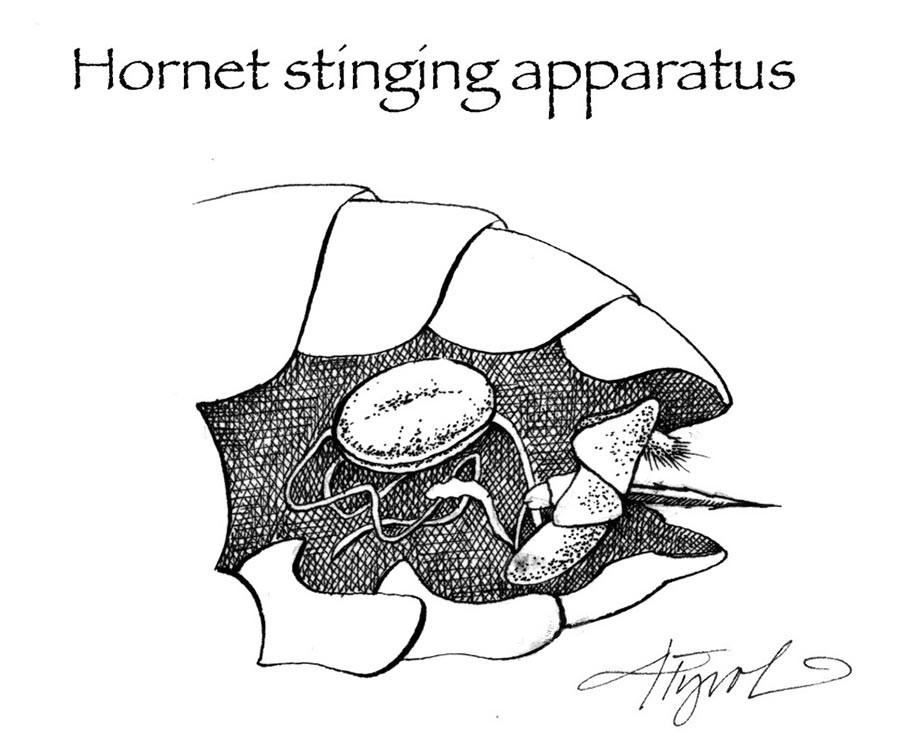
As a boy, I was exploring the loft of my grandmother’s barn when I disturbed a bumblebee nest among the moldering hay bales. In my memory, I leap stuntman-like from the haymow and hit the ground 10 feet below running flat out, rounding the corner of the barn then glancing back to see if anyone is in pursuit. There is an angry bumbler coming up fast. I vault the rusty ornamental fence and am steps from the screen door and safety when . . . I get nailed in the neck. Ow!
When we lived in Louisiana, I scalped a fire-ant nest while mowing the lawn and got stung a few hundred times as the ants swarmed up my legs. Vivid memory. I’ve been stung by several varieties of wasps and, as a beekeeper, I periodically get stung by my honey bees. Yes, it still hurts.
Insect stings are weapons. Their purpose is to hurt: to deter, or at least discourage, predators. Stinging insects include honey bees, bumblebees, wasps, hornets, and ants.
While no one likes to get stung, you have to admire the hardware.
“A marvelously functional device,” entomologist and author Justin O. Schmidt called the sting in his fascinating, quirky, and tremendously readable book, The Sting of the Wild. “The original biological syringe complete with a needle and a chamber that holds the liquid that’s injected through the needle.”
The stinger evolved eons ago from the ovipositors – hollow tubes used to inject eggs into plant material – in primitive sawflies. Schmidt wrote, “The significant evolutionary change in the stinger, which dramatically altered its role, was the addition of a cocktail of venom,” at the same time the stinger’s ovipositor function became obsolete in many bees and wasps.
This change set the stage for a blowout of stinging insect diversity and the development of insect sociality among bees, wasps, and ants, he points out. Interestingly, male stinging insects can’t sting because – well, they never would have had an ovipositor, right?
Stings work because the shaft has three parts: two mobile shafts slide in channels on the fixed third part, Schmidt explains in his book. Muscles slide one mobile piece in, then the other; this pushes the fixed part in further. Honey bees have a strongly barbed stinger, which helps guarantee that the fixed part doesn't slide back out. Some wasps, such as yellow jackets, have a stinger with very fine barbs. Other wasps and bees have smooth stingers. Once in, powerful muscles surrounding the venom reservoir contract and push the venom into the victim. This all occurs in a fraction of a second.
Though many stinging insects can sting repeatedly, a honey bee sting is often a death sentence, as the stinger and venom sacs are pulled out of the bee. Interestingly, this only occurs when they sting victims with flexible skin, like humans. Honey bees can sting other insects without losing their defensive equipment.
The venom of a stinging insect usually causes pain, significant swelling, and redness – in susceptible people it can cause anaphylactic shock. While all stings hurt, they don’t all hurt equally. Schmidt has garnered considerable acclaim for his Schmidt Pain Scale for Stinging Insects. It rates more than 80 species of insects using a four-point scale. The ratings are based on his experience. One is the least painful, and four is the most. Schmidt supplements the ratings with vivid descriptions reminiscent of wine-tasting notes.
Luckily, most stinging insects in northern New England score ones and twos.
Sweat bees, for instance, score a one: “Light and ephemeral, almost fruity. A tiny spark has singed a single hair on your arm.”
The European honey bee scores a two: “Burning, corrosive . . . a flaming match head lands on your arm and is quenched first with lye and then sulfuric acid.” Bumblebees, also a two: “Colorful flames. Fireworks land on your arm.” Bald-faced hornets, as well: “Rich, hearty, slightly crunchy. Similar to getting your hand mashed in a revolving door.” And a two for the common yellow jacket: “Hot and smoky, almost irreverent. Imagine W.C. Fields extinguishing a cigar on your tongue.”
The Florida harvester ant is a three: “Bold and unrelenting. Somebody is using a power drill to excavate your ingrown toenail.”
A four? Well, that would be the tarantula hawk, a solitary wasp that preys on big, hairy spiders: “Blinding, fierce, shockingly electric. A running hair dryer has just been dropped into your bubble bath.” Or the bullet ant of Central and South America: “Pure, intense, brilliant pain, like walking over flaming charcoal with a three-inch nail embedded in your heel.”
Owwww!


Discussion *